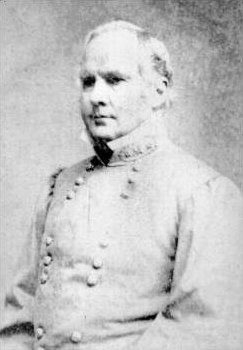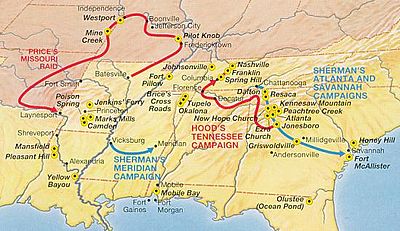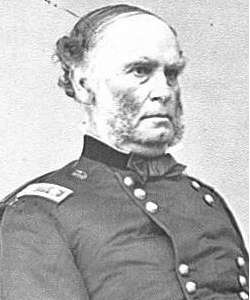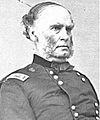Army of Missouri facts for kids
Quick facts for kids Army of Missouri |
|
|---|---|

Maj. Gen. Sterling Price, CSA, Commander, Army of Missouri
|
|
| Active | September 8 – December 3, 1864 |
| Country | |
| Branch | |
| Engagements | Battle of Fort Davidson Battle of Glasgow Fourth Battle of Boonville Battle of Sedalia Second Battle of Lexington Battle of Little Blue River Second Battle of Independence Battle of Byram's Ford Battle of Westport Battle of Marais des Cygnes Battle of Mine Creek Battle of Marmiton River Second Battle of Newtonia |
| Disbanded | Absorbed into Army of the Trans-Mississippi |
| Commanders | |
| Notable commanders |
Sterling Price John B. Clark, Jr. |
The Army of Missouri was a special military group during the American Civil War. It was part of the Confederate States Army. This army was formed in the fall of 1864. Its leader was Maj. Gen. Sterling Price. Their main goal was to invade Missouri.
Price's plan, known as Price's Raid, did not work out. His army had to go back to Arkansas. There, it was broken up and joined with another Confederate group, the Army of the Trans-Mississippi. After the war, Price and his officer, Brig. Gen. Jo Shelby, moved to Mexico. They tried to join the army of Emperor Maximilian but were not successful. Later, they returned to the United States.
Contents
How the Army of Missouri Started
The Army of Missouri began from the Missouri State Guard. This group was formed in 1861 by Sterling Price. Its job was to keep Missouri "neutral" in the war. This meant Missouri would not pick a side, but would defend itself.
However, the Guard soon joined the Confederate States Army. This happened after fights with Union troops. Union soldiers, led by Nathaniel Lyon, removed the elected governor, Claiborne Jackson. They put in a new governor who supported the Union. As the Missouri State Guard, they won battles at the First Battle of Lexington and Wilson's Creek. General Lyon was killed at Wilson's Creek.
Price and his troops later became part of Maj. Gen. Earl Van Dorn's Army of the West. They lost battles at Pea Ridge, Arkansas, Iuka, Mississippi, and Corinth, Mississippi. After the Battle of Corinth, Confederate President Jefferson Davis sent Price back to Missouri. But Price did not get to take his old troops with him. He had to gather a new force. He then helped the Southern efforts in Arkansas.
By late summer 1864, many Union Army soldiers in Missouri had moved east. They were helping in other big battles, like the one to take Atlanta. The Confederacy wanted Gen. E. Kirby Smith to send his soldiers across the Mississippi River. This would help the struggling Southern troops in the east.
But Smith had a different idea. He wanted to "free" Missouri from Union control. He planned to capture St. Louis and the state capital, Jefferson City. He hoped to bring back the Confederate governor. Smith decided to send a large group of mounted soldiers and cavalry. This force would be led by former Missouri governor Sterling Price. Smith also hoped this plan would hurt Union President Abraham Lincoln's chances of being re-elected. Price was very excited about this mission. He named his new command "The Army of Missouri".
St. Louis was defended by only 8,000 Union troops at first. Later, more Union soldiers arrived. If Price could capture St. Louis, he would get its huge arsenal and many supplies. This could change the war, even with Union wins in Georgia and Virginia. It might have led to Lincoln losing the election.
How the Army Was Set Up
The Army of Missouri was divided into three divisions. These were led by Maj. Gen. James F. Fagan, Maj. Gen. John S. Marmaduke, and Brig. Gen. Joseph O. Shelby. All of them were experienced fighters. The army also had fourteen cannons.
Price's soldiers were a mixed group. Some soldiers had left their previous units without permission. Many soldiers had no personal gear, like canteens or ammunition boxes. They often carried jugs for water. They stuffed ammunition into their shirt and pants pockets. Nearly 4,000 soldiers had no weapons. Price could not get enough guns for all of them.
Price's orders were to attack St. Louis first. If St. Louis was too strong, he was to go to Jefferson City. From there, Price was to move west into Kansas and then south. He was to gather horses, cattle, and military supplies along the way.
The Missouri Expedition
Price's army started its journey from northeastern Arkansas on September 16, 1864. They moved into Missouri. They decided to attack the Union base at Ft. Davidson near Pilot Knob. This battle cost Price over 1,000 men and valuable time. The fort was not very important.
Price could not continue to St. Louis because Union forces were too strong. So, Price turned west toward Jefferson City. Small fights there showed him that the capital could not be taken either. Price then continued further west toward Kansas City and Fort Leavenworth, Kansas.
There were smaller fights between Price's army and Union groups. These happened at Boonville and Glasgow. One of Price's groups also fought Union militia at Sedalia. The Confederates won all these smaller battles.
As Price moved west, his army collected a very long wagon train. This train was full of captured goods and supplies. They also had a large group of horses and cattle. This long line of wagons made it harder for Price to move quickly. It became a big problem for his army when they had to retreat after their defeat at Westport.


Union forces in Missouri were quickly getting ready to stop Price. Maj. Gen. Samuel R. Curtis led these Union forces. Curtis gathered militia units from Missouri and Kansas. He also had regular infantry and cavalry units. Together, they formed the Army of the Border, with about 35,000 men.
Meanwhile, Price's army was getting smaller. Soldiers were leaving without permission, or getting sick. By the time of the important Battle of Westport, Price's army had only 8,500 men. Besides Curtis's army, Price was also being chased by Union Cavalry. This group was led by Maj. Gen. Alfred Pleasonton.
Price's first real challenge against this new Union force was at Lexington. He pushed parts of Curtis's army back toward the Little Blue River and Independence. More wins at these two places put Price's army near Westport. Curtis's main army was waiting there.
Pleasanton's cavalry finally caught up with Price at Independence. This trapped the Army of Missouri between two Union armies. Each Union army was larger than Price's entire force. This led to the Battle of Westport. This battle is sometimes called the "Gettysburg of the West." Price's army was completely defeated. He had to retreat south through Kansas toward the Indian Territory (which is now Oklahoma).
Price's army suffered more defeats. These happened at the Marais des Cygnes River, Mine Creek, the Marmiton River, and Newtonia. These losses forced Price to retreat all the way into Arkansas and eastern Texas. He did this to avoid more Union troops. The tired remains of Price's army finally returned to Arkansas on December 2. They had lost about 6,000 men. The Army of Missouri officially ended when these men joined the Army of the Trans-Mississippi. Price then commanded its Cavalry Corps from December 3, 1864, to March 12, 1865.
Journey to Mexico
Instead of giving up at the end of the Civil War in 1865, Price and his officer Jo Shelby led many of their remaining troops to Mexico. Price hoped to join the Mexican emperor Maximilian's army. This did not happen, but Maximilian did give them land for a settlement near Vera Cruz.
About a year later, this settlement failed. Maximilian was overthrown and executed by the government of Benito Juárez. Price, Shelby, and most of their men decided to return to the United States. The story of Price and Shelby's adventure in Mexico later inspired the John Wayne and Rock Hudson movie The Undefeated.
Why the Army of Missouri Failed
Military expert Dale E. Davis studied why Price's Army of Missouri failed. He suggests that Price did not use a strategy called "compound warfare" correctly. This strategy is when a weaker army uses both regular soldiers and smaller, independent groups to fight a stronger army.
Davis also said that Price moved too slowly. He wasted valuable time, ammunition, and men attacking places like Fort Davidson, Glasgow, Sedalia, and Boonville. These places were not very important. This gave Union General Rosecrans time to organize a strong defense.
Price should have used Confederate bushwackers (small, independent fighting groups) to bother Union forces. This would have made the Union spread out their troops to chase them. This would have left fewer Union soldiers to fight Price's main army. Instead, Price kept many guerrilla fighters close to his army. He even put some into his main groups. This meant he did not use their speed and small size to his advantage.
Because of this, Union generals were able to bring together a large enough force. They trapped and defeated Price at Westport. This ended his campaign and led to the end of the Army of Missouri.
Commanders
- Major General Sterling Price (September 8-December 3, 1864)
- Major General John B. Clark, Jr. (temporary: December 3, 1864)
Battles Fought
- Battle of Fort Davidson (September 27, 1864)
- Fourth Battle of Boonville (October 11, 1864)
- Battle of Glasgow (October 15, 1864)
- Battle of Sedalia (October 15, 1864)
- Second Battle of Lexington (October 19, 1864)
- Battle of Little Blue River (October 21, 1864)
- Second Battle of Independence (October 24, 1864)
- Battle of Byram's Ford (October 22–23, 1864)
- Battle of Westport (October 23, 1864)
- Battle of Marais des Cygnes (October 25, 1864)
- Battle of Mine Creek (October 25, 1864)
- Battle of Marmiton River (October 25, 1864)
- Second Battle of Newtonia (October 28, 1864)
Images for kids



